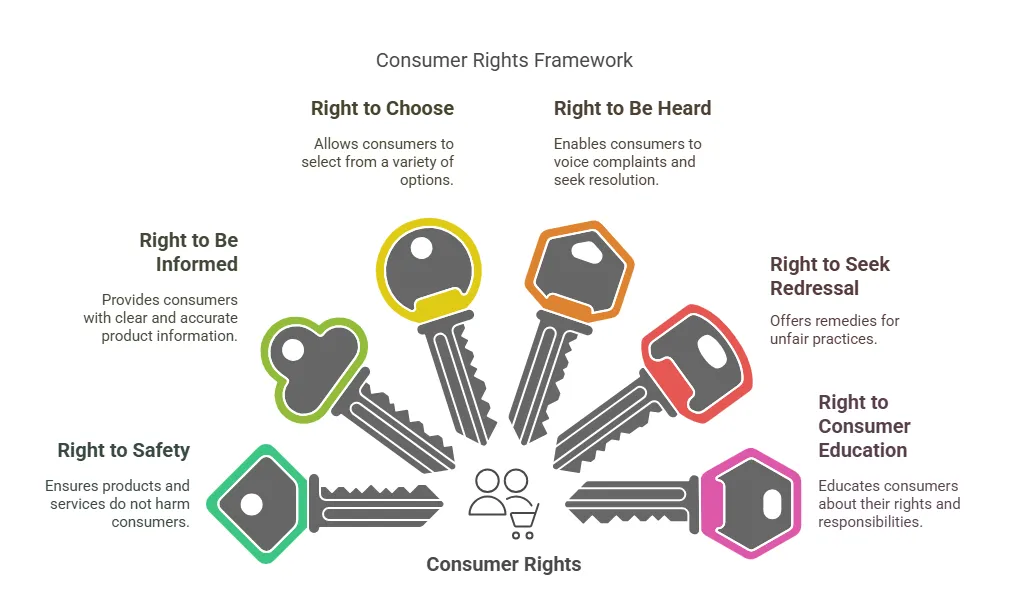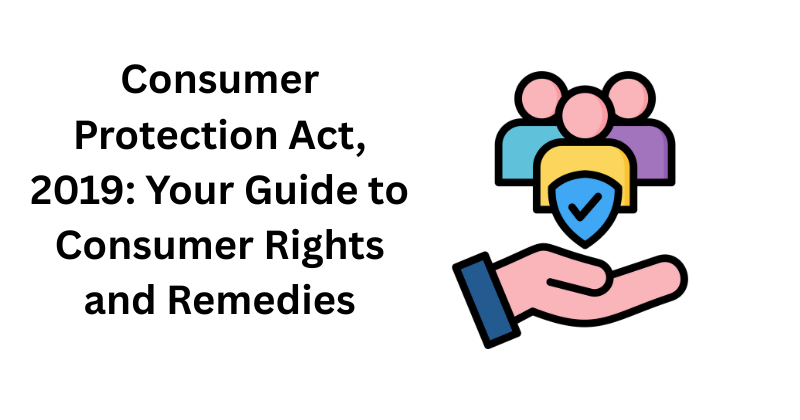The Consumer Protection Act, 2019, is a landmark law that protects consumer rights in India, ensuring buyers get fair treatment in transactions. For BBA students, understanding the Act’s consumer rights and consumer remedies is vital for business law exams and real-world applications. This article explains the Act’s core provisions, six consumer rights, remedies, dispute forums, online trade rules, and hurdles, with clear examples to ease understanding.
What Is the Consumer Protection Act, 2019?
Enacted on August 9, 2019, the Consumer Protection Act, 2019, replaced the 1986 Act to address modern issues like online shopping and unfair trade practices. It applies to all goods and services, ensuring consumers are protected in both offline and online markets. The Act is a key part of the BBA syllabus, often tested for its rights and redressal mechanisms.
A 2024 report by Legal Service India noted a 40% rise in consumer complaints since 2019, driven by e-commerce growth, highlighting the Act’s significance.
Key Features of the Act
The Act introduces several mechanisms to strengthen consumer rights:
- Central Consumer Protection Authority (CCPA): A national body to regulate unfair practices, issue recalls, and impose fines up to ₹50 lakh.
- Product Liability: Sellers and manufacturers are accountable for defective goods causing harm.
- E-Commerce Rules: Guidelines for online platforms to ensure transparency and accountability.
- Mediation: Alternative dispute resolution to speed up redressal.
These features make the Act a powerful tool, often covered in exam questions on consumer protection frameworks.
Six Consumer Rights Under the Act
The Consumer Protection Act grants six consumer rights to empower buyers:
- Right to Safety: Protection from goods/services that endanger life or property.
- Example: A gas cylinder must be tested to prevent leaks.
- Right to Be Informed: Access to clear details about product quality, price, and risks.
- Example: A medicine must list its side effects.
- Right to Choose: Freedom to select from a variety of goods at fair prices.
- Example: Picking between different brands of headphones online.
- Right to Be Heard: Consumers can file complaints and expect action.
- Example: Raising a grievance for a defective appliance.
- Right to Seek Redressal: Remedies for unfair practices, like refunds or replacements.
- Example: Getting a new phone for a faulty one.
- Right to Consumer Education: Awareness of rights and responsibilities.
- Example: Learning to spot misleading ads through campaigns.

Table: Six Consumer Rights
| Right | Description | Example |
|---|---|---|
| Safety | Protection from hazardous goods | Safe electrical appliances |
| Be Informed | Access to product details | Clear food labeling |
| Choose | Variety of options at fair prices | Multiple online product options |
| Be Heard | Voice complaints | Filing a product grievance |
| Seek Redressal | Remedies for unfair practices | Refund for defective goods |
| Consumer Education | Awareness of rights | Campaigns on fake products |
Exam Tip: Memorize these rights with examples, as they’re frequent in short-answer and descriptive questions.
Understanding Valid Contracts and Types of Contracts Under the Indian Contract Act
Consumer Remedies Under the Act
The Act provides consumer remedies to address violations:
- Refund or Replacement: Return or replace faulty goods.
- Example: Replacing a defective laptop.
- Compensation: Money for losses or harassment.
- Example: ₹10,000 for injuries from a faulty gadget.
- Removal of Defects: Free repairs for goods/services.
- Example: Fixing a car under warranty.
- Stop Unfair Practices: Ban misleading ads or fake goods.
- Example: Stopping false “organic” product claims.
- Punitive Damages: Fines for severe violations.
- Example: Penalties for selling unsafe food items.
A 2024 article by Economic Times reported a surge in remedy claims, reflecting the Act’s enforcement.
Consumer Courts: Redressal Mechanism
The Act establishes Consumer Disputes Redressal Commissions at three levels:
- District Commission: Claims up to ₹50 lakh.
- Example: Dispute over a ₹30,000 defective product.
- State Commission: Claims from ₹50 lakh to ₹2 crore.
- Example: Issue with a ₹1 crore vehicle.
- National Commission: Claims above ₹2 crore.
- Example: Large-scale fraud in a major transaction.
Filing Process:
- Submit a complaint (online or offline) with proof (e.g., receipt).
- Pay a nominal fee (e.g., ₹500 for claims up to ₹20 lakh).
- Attend hearings; cases often resolve in 3-6 months.
- Appeals can escalate to higher commissions.
Exam Tip: Know claim limits and the filing process for numerical questions.
E-Commerce Rules Under the Act
The Consumer Protection (E-Commerce) Rules, 2020, ensure fairness in online markets:
- Transparency: Full disclosure of product price, expiry, and seller details.
- No Manipulation: Ban on fake reviews or price rigging.
- Grievance Officers: Platforms must appoint officers to address complaints within 48 hours.
- Returns: Refunds or replacements for defective goods within 7-14 days.
Example: A buyer can return a torn shirt bought online and expect a refund.
Central Consumer Protection Authority (CCPA)
The CCPA, established under the Act, plays a key role in protecting consumer rights:
- Powers: Issues safety notices, recalls defective goods, and fines violators.
- Example: Ordering a recall of unsafe toys.
- Impact: Ensures proactive enforcement, reducing unfair practices.
A 2023 report by Business Standard noted the CCPA’s role in resolving online disputes.
Challenges in Implementation
Despite its strengths, the Act faces hurdles:
- Awareness Gaps: Many consumers don’t know their rights.
- Example: Buyers accept defective goods due to lack of knowledge.
- Court Delays: Some cases take longer than 6 months.
- Example: Complex disputes may escalate to state commissions.
- E-Commerce Compliance: Online sellers sometimes dodge rules.
- Example: Fake products sold through unregistered vendors.
Addressing these challenges is key to strengthening consumer remedies.
Tips to Master the Consumer Protection Act
To shine in exams:
- Learn the Rights: Know the six rights and their legal basis (e.g., Section 49 for redressal).
- Study Remedies: List all remedies with generic examples.
- Understand Courts: Memorize commission levels and processes.
- Check Resources: Visit India Kanoon for legal insights.
- Prep for Vivas: Explain the CCPA’s role in consumer protection.
Conclusion
The Consumer Protection Act, 2019, empowers consumers with consumer rights and consumer remedies, making it a critical law for BBA students. From safety to redressal, the Act ensures fair transactions, especially in e-commerce. By mastering its rights, remedies, and mechanisms, you’ll excel in exams and internship projects. Dive into resources like Legal Service India to deepen your knowledge, and keep studying to ace consumer protection!
👨💼 Author: BBAProject Editorial Team
✍️ The BBAProject Editorial Team comprises business graduates and educators dedicated to creating practical, syllabus-based learning resources for BBA students.
⚠️ Please Note: Articles published on BBAProject.in are well-researched and regularly updated. However, students are advised to verify data, statistics, or references before using them for academic submissions.

